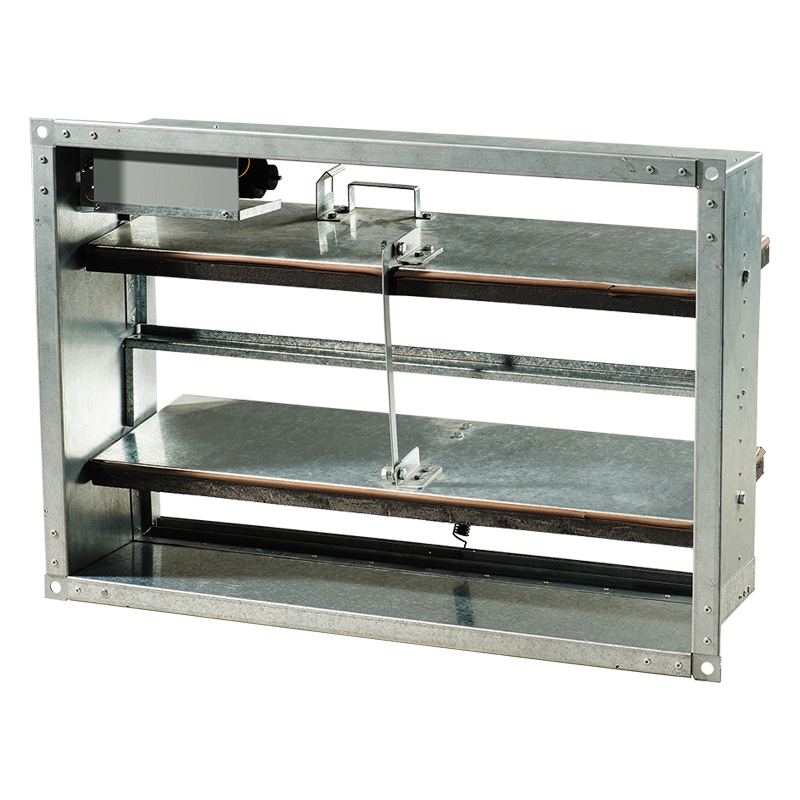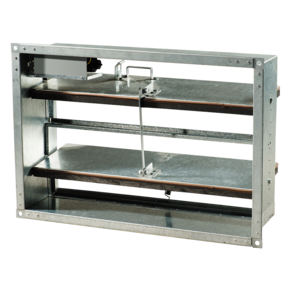APPLICATION
- The dampers are intended for integration into smoke control systems of buildings and structures of various purpose and designed for extraction of combustion products from the spaces of floor corridors, hallways, air locks etc.
- The dampers can be used as smoke dampers in emergency smoke extraction ventilation systems in the event of a fire to support evacuation of people from the building at the initial phase of the fire occurring in any of the building spaces.
- The KPDU multi-purpose fire safety smoke dampers are rated to resist fire for 180 minutes (E 180) at the temperature of 600 °C.
DESIGN
- The damper casing is made of galvanised steel 1.5 mm thick. The dampers are available in the wallmounted or duct-mounted variant which have either one or two attachment flanges.
- The units are available in 3 control variants:
- With an electric magnet (220 or 24 V). The damper opens via a spring when the electric magnet is energized. When the damper reaches the end position, a limit switch opens the circuit disconnecting the electric magnet from the power mains. The electric magnet must not remain energized for more than 10 seconds. The damper is reset to the safety (closed) position manually by means of a handle. The damper equipped with an electric magnet has a special button for testing the unit performance.
- With a 230 or 24 V electric actuator and a return spring. The flaps are automatically set to the normal (closed) position when applying voltage to the electric actuator. On a fire alarm signal the electric actuator is de-energized causing its return spring to set the damper to an open position. The electric actuator is equipped with a contact group to signal its end positions. The damper can also be controlled manually and fixed in any position. The unit can be unlocked either manually using a hex wrench or automatically upon power-up.
- With a 230 or 24 V electric actuator and two-wire control. The damper flap is set from the "Open" to the "Closed" position by an external command sending the voltage phase from one actuator contact to the other. The electric actuator is equipped with a contact group to signal its end positions. The damper can be controlled manually by means of a hex key.
- Note. The KPDU dampers with a height of 300 and 350 mm have one louvre. The main difference between the KPDU and the KPD dampers with a similar height of 300 and 350 mm is that the method of fastening the flap, which ensures a smaller overhang of the flap beyond the KPDU valve.
|
MOUNTING
- The dampers are not intended for installation in air ducts and ducts of spaces with fire and explosion hazard categories A and B, in local exhaust systems designed for extraction of flammable and explosive mixtures as well as in systems containing environments more aggressive to plain carbon steels than air or those containing sticky and fibrous materials. Fire safety dampers are only intended for installation in systems subjected to regular cleaning to prevent formation of flammable deposits. The damper must be installed into the building envelope structure in accordance with the applicable standards and regulations.
- The seal fire resistance must be at least equal to that of the building envelope. When preparing for installation the damper casing should be fitted with wooden spreader bars to prevent deformation, torsional twisting or geometry perturbation of the casing which may result in louvre jamming and, eventually, loss of the damper functionality.
- Upon completion of the damper brickwork envelope in the smoke shaft, fire division wall or flooring and complete cure (setting) of the sealing, remove the wooden spreader bars and check the louvre for free and frictionless opening. Ground the damper, connect the electric magnet or electric actuator (depending on the modification) to the automatic firefighting system and test the damper actuation.

|






 Domestic fans
Domestic fans  Industrial and commercial fans
Industrial and commercial fans  Single-room ventilation systems with heat recovery
Single-room ventilation systems with heat recovery  Air handling units
Air handling units  Air heating systems
Air heating systems  Smoke extraction and ventilation
Smoke extraction and ventilation  Accessories for ventilating systems
Accessories for ventilating systems  Electrical accessories
Electrical accessories  Ventilation ducts and fittings
Ventilation ducts and fittings  Air distribution components
Air distribution components  Ventilation kits and vents
Ventilation kits and vents 

